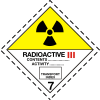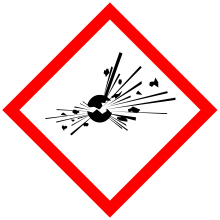HAZMAT Class 7 Radioactive substances
Radioactive substances are materials that emit radiation.
Divisions

Radioactive label on containers aboard a US Navy ship.
Any quantity of packages bearing the RADIOACTIVE YELLOW III label (LSA-III).
Some radioactive materials in "exclusive use" with low specific activity radioactive materials will not bear the label, however, the RADIOACTIVE placard is required.
Placards
|
Compatibility Table
| Load and Segregation Chart | ||||||||||||||||||||||
|---|---|---|---|---|---|---|---|---|---|---|---|---|---|---|---|---|---|---|---|---|---|---|
| Weight | 1.1 | 1.2 | 1.3 | 1.4 | 1.5 | 1.6 | 2.1 | 2.2 | 2.2 | 2.3 | 3 | 4.1 | 4.2 | 4.3 | 5.1 | 5.2 | 6.1 | 7 | 8 | |||
| A | B | A | ||||||||||||||||||||
| 7 - I | N/A | B | ||||||||||||||||||||
| 7 - II | N/A | B | ||||||||||||||||||||
| 7 - III | Any Quantity | B | O | |||||||||||||||||||
| Key | ||||||||||||||||||||||
The absence of any hazard class or division or a blank space in the table indicates that no restrictions apply.
| ||||||||||||||||||||||
gollark: Your diode *isn't* digitally controllable?
gollark: The I²C hardware checks against the global I²C allowed address database™ on bootup.
gollark: Your I²C transceiver implodes.
gollark: This is also possible.
gollark: Makes allocating them centrally very weird.
References
- 49CFR 173 Subpart I
- Federal Emergency Management Agency; United States Department of Energy (June 2010). "Radioactive Materials - Transport and Incident Response" (PDF). p. 14. Archived from the original (PDF) on 8 May 2017. Retrieved 20 July 2019.
- Pipeline and Hazardous Materials Safety Administration (PHMSA) (October 1, 2011). "49 CFR 177.848 - Segregation of hazardous materials" (PDF). Government Publishing Office. p. 853. Archived from the original (PDF) on 16 July 2019. Retrieved 16 July 2019.
This article is issued from Wikipedia. The text is licensed under Creative Commons - Attribution - Sharealike. Additional terms may apply for the media files.



